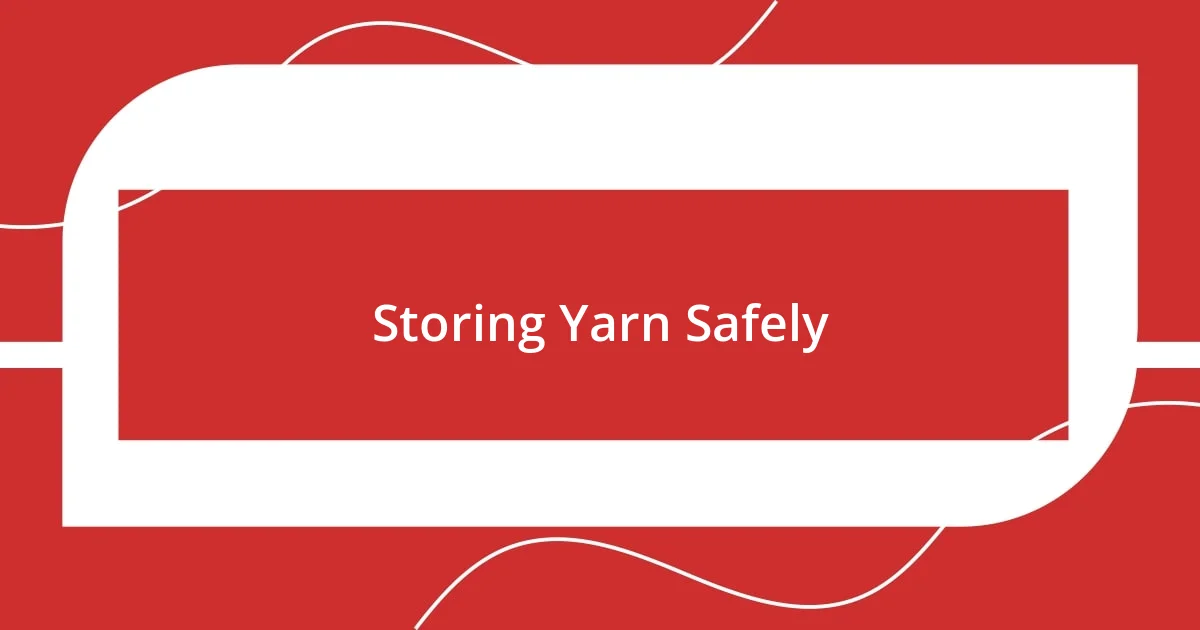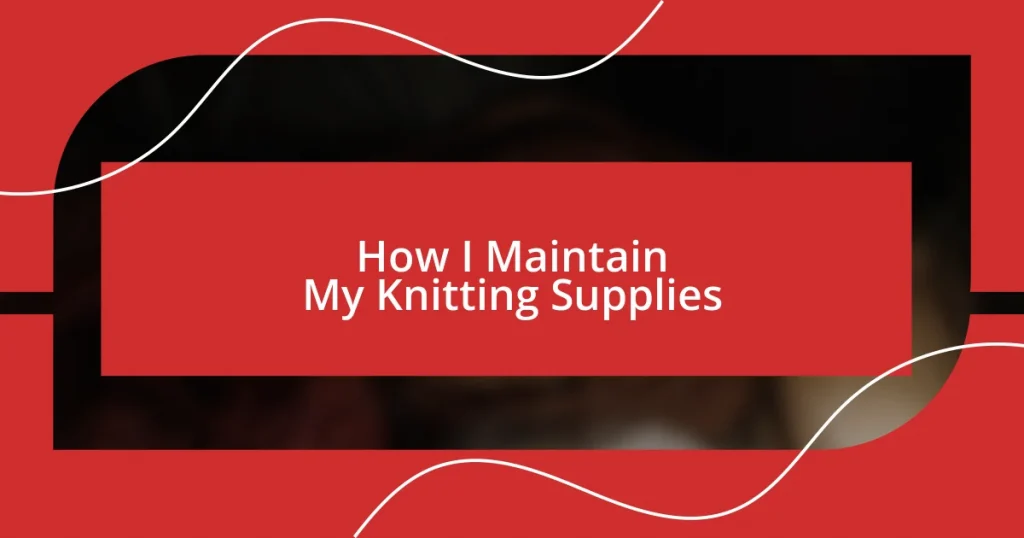Key takeaways:
- Regularly assessing and organizing knitting supplies using labeled bins and designated zones enhances efficiency and reduces stress during projects.
- Implementing safe storage methods, such as using airtight containers and avoiding direct sunlight, preserves yarn quality and prevents damage.
- Maintaining a knitting journal helps track progress, document ideas, and foster creativity by reflecting on past experiences and planning future projects.

Assessing My Knitting Inventory
Assessing my knitting inventory feels a bit like a treasure hunt. Every time I dive into my stash, I discover forgotten skeins that spark a wave of nostalgia, reminding me of projects past. Have you ever pulled out a ball of yarn and thought, “What was I planning to create with this?”
I usually break down my inventory into categories: yarns, needles, and notions. When I do this, I can see at a glance what I have on hand—it’s like getting clarity in my creative process. Just the other day, I found a set of circular needles that had slipped to the back of my storage box, and it was almost like reuniting with an old friend who’s been missed.
Regularly assessing my collection helps me avoid impulse buys, something I’ve struggled with in the past. Once, I let excitement get the best of me and ended up with ten skeins of an unusual color that didn’t match anything I had. Since then, I’ve learned to create a digital inventory, so I can make informed choices without compulsion. It’s not only practical; it’s a way to cherish and respect the yarn I have.

Organizing My Knitting Supplies
I keep my knitting supplies organized using a combo of bins and labels. It’s incredible how much easier my knitting sessions become when everything has a proper home. I remember one chaotic day when I needed a specific color yarn for a project. After rifling through a messy heap of supplies, I ended up frustrated and late to a knitting group. Now, with labeled bins, I can locate my materials in a flash, which feels like a mini-victory every time I start a new project.
Creating zones in my storage space has also made a big difference. By designating areas for different types of supplies—like one spot for yarns and another for tools—I’ve managed to maximize my efficiency. I sometimes think of it as a knitting command center. Not only does it reduce stress, but it also allows me to focus fully on the joy of crafting. Just last week, I was able to whip up two cozy hats in one evening simply because I had all my supplies neatly organized and accessible.
Lastly, I’ve found that using clear containers allows me to admire my yarn as I go. There’s something uplifting about seeing all those vibrant colors lined up, which often inspires me. It reminds me of a beautiful rainbow—each skein a unique story waiting to unfold. I learned this from a friend who told me that the visual appeal could ignite creative ideas. Now, whenever I look at my organized supplies, I feel a surge of inspiration, ready to embark on my next knitting adventure.
| Organization Method | Benefits |
|---|---|
| Labeled Bins | Easy access and quick identification |
| Designated Zones | Enhances focus and workflow |
| Clear Containers | Visual appeal and creative inspiration |

Storing Yarn Safely
Yarn safety is crucial for maintaining the quality of my knitting supplies. I’ve learned that keeping yarn away from direct sunlight not only prevents colors from fading but also helps avoid any potential damage to the fibers. I once had a beautiful skein of hand-dyed wool that lightened significantly after being left out by the window for too long. It was heartbreaking to see, so now I store my yarn in a dark, cool area.
Here are some specific strategies I use to store my yarn safely:
- Use airtight containers: They keep out dust and pests, preserving my yarn’s freshness.
- Avoid plastic bags: They can trap moisture, leading to mildew, which is something I now steer clear of after losing a few skeins.
- Keep away from pets: I can’t resist the sight of my cat snuggling with yarn, but I’ve learned to set boundaries. An unexpected play session often leads to tangled yarn chaos.
- Label everything: I’ve begun to label my yarn materials with their fiber content and care instructions, which saves me time when planning projects.
By implementing these simple storage methods, I’ve not only protected my yarn but also ensured I have it on hand and ready for crafting whenever inspiration strikes.

Caring for Knitting Tools
Caring for my knitting tools is just as important as organizing my supplies. Sharp needles and smooth crochet hooks deserve attention too. I’ve developed a routine where I gently clean my tools after each project. A soft cloth and some mild soap do wonders for removing any grime or residue. It might sound simple, but I find a clean tool makes for a smoother knitting experience, and I can’t help but feel a bit more inspired when I reach for well-maintained needles.
I’ve also learned that storing my tools properly can extend their lifespan. I keep my circular and straight needles separated in their original cases, which not only protects them from damage but also prevents them from getting tangled—a frustration I know all too well. It’s like trying to sort out a gigantic knot in yarn, and you end up with shaky hands and a sigh! By using individual pouches, I also ensure I can locate the right needle size without rummaging through a jumble of items.
Lastly, I find joy in occasionally checking for any signs of wear and tear. For instance, I once noticed a tiny nick on a favorite pair of wooden needles, which could have led to an uneven stitch. That experience taught me the value of regular inspections. So, do you ever give your tools a little TLC? I’ve discovered that taking these small steps to care for my knitting tools not only keeps them functional but also creates a deeper connection to my craft.

Maintaining a Knitting Journal
Maintaining a knitting journal has become one of my favorite ways to track my progress and jot down ideas. I started mine a few years ago after finishing a complex sweater project, and I found it incredibly helpful to reflect on what worked (and what didn’t) during the process. Like when I attempted an intricate cable stitch for the first time; I noted my frustrations, but also the joy when I finally got it right. Does documenting these moments sound tedious? Trust me, it’s quite the opposite!
I’ve also made it a habit to record yarn details and needle sizes for each project, which has saved me from second-guessing during my next crafting session. I remember one time I completely forgot which yarn I used for a scarf I loved, and without my journal, I’d have been lost trying to replicate that color. My journal isn’t just a record; it’s a treasure trove of memories and milestones that helps me celebrate my growth as a knitter. How fulfilling is it to look back and see the progression of your skills?
Lastly, I’ve started to include sketches and patterns, as well as any ideas I have for future projects. I once sketched a design that mirrored the trees I saw during a trip to the mountains, and that vision turned into a stunning shawl! Engaging creatively in my journal allows my inspiration to flourish, creating an intrinsic link between my experiences and my craft. Have you thought about starting a knitting journal? I believe you’ll find the process rewarding, and it might just spark new ideas you never knew you had!

Tips for Efficient Rotating Supplies
To efficiently rotate my knitting supplies, I’ve found that scheduling a monthly inventory works wonders. It might sound a bit formal, but I set aside a quiet Saturday morning to pull everything out. I sort through my yarns, checking for any that I haven’t used in a while, and then I make a mental note (or sometimes a list) of what I need to incorporate into my projects soon. Have you tried this? It feels like a mini treasure hunt, rediscovering those forgotten skeins that were once bought with so much excitement!
Another strategy I’ve adopted involves creating a rotation system based on seasons or project types. For instance, when fall approaches, I’ll consciously set aside lighter yarns in favor of richer, cozier fibers that match the season’s vibe. I can vividly recall the thrill of finally using that deep burgundy wool I had saved for chillier months. Isn’t it satisfying when a plan aligns perfectly with your creative mood?
Lastly, I’m a big advocate for keeping my workspace visually appealing and organized. I love using clear containers so I can see exactly what I have at a glance. It not only saves time, but also fuels my creativity—who doesn’t feel more inspired when surrounded by a colorful array of materials? I remember one rainy afternoon when I rearranged my supplies and suddenly felt energized to start a new project that had been sitting on the back burner. Don’t you think that a tidy and vibrant environment can spark new ideas?

Upgrading My Knitting Essentials
Upgrading my knitting essentials is always an exciting endeavor for me. Recently, I decided to invest in a set of ergonomic knitting needles. I remember the sense of relief when I first tried them; my hands had always ached after long knitting sessions, but these needles changed everything. It’s amazing how the right tools can elevate your experience, don’t you think?
I’ve also started experimenting with specialty yarns that can enhance the textures in my projects. There’s a local shop where I found a luxurious silk blend, and using it in a scarf project felt like wrapping myself in a dream. Each time I work with those delicate strands, it’s a reminder of the importance of choosing quality materials. Have you felt that rush of joy when the perfect yarn meets your vision?
Another upgrade I made was investing in storage solutions that not only keep my supplies organized but also serve as a source of inspiration. I found beautiful wooden boxes that showcase my yarns, making my workspace feel like a cozy craft haven. It’s incredible how an aesthetically pleasing environment can spark creativity—like the time I gazed at my colorful stash and suddenly envisioned a vibrant rainbow blanket. Isn’t it inspiring to see your materials prepped and ready to become something extraordinary?















